
Encounter at Gubanovka, 1943
18th April 2024, 2 Comments
The Second World War, Iron Cross, 10mm
We fancied a ‘treadfest’ this week, and that’s exactly what we got! Sean and I (with some help from Aly) staged a small 10mm game set on the Eastern Front, shortly after Kursk. Sean took the Soviets, which left me with Das Reich. The game was played out on a 6×4 foot table, dominated by a shallow river, some hills, woods and a small village outside the town of Gubanovka, about 20 miles south of Kursk. 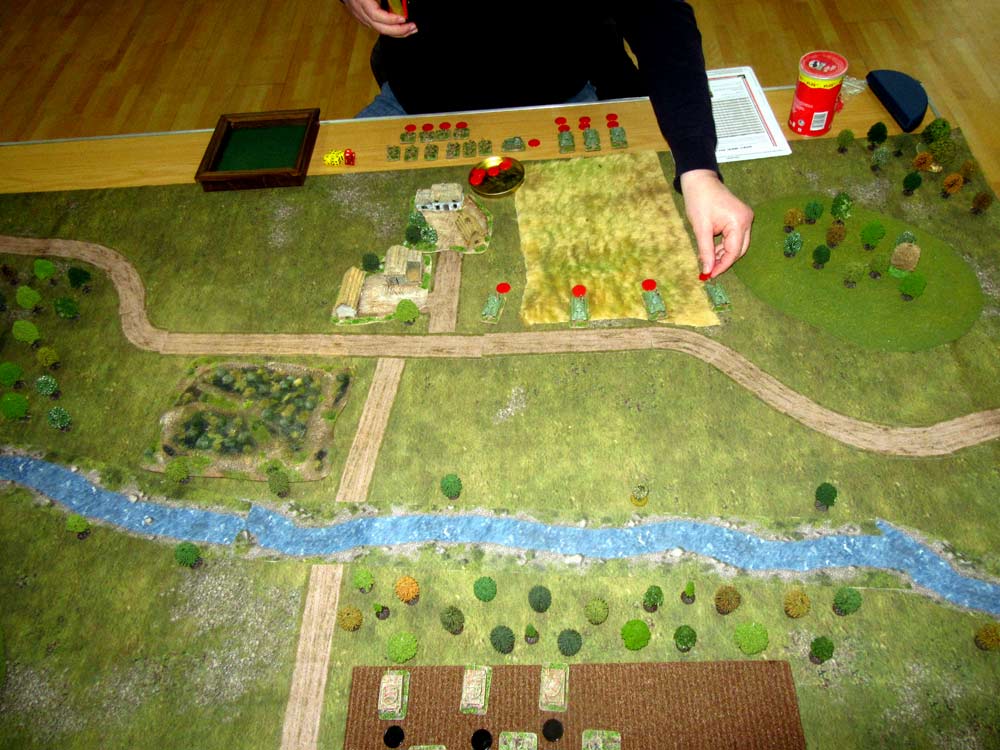 This was a game where most of our toys entered the table as reinforcements, so the initial clash sort of expanded as we went on. Before we go on, let me explain the little counters. In Iron Cross you activate a unit (a tank or a stand of infantry) to move and shoot. You have a pool of counters – one per unit, plus one – and you expend one of these every time you activate. You can activate more than once, but the more you try, the harder the activation gets.
This was a game where most of our toys entered the table as reinforcements, so the initial clash sort of expanded as we went on. Before we go on, let me explain the little counters. In Iron Cross you activate a unit (a tank or a stand of infantry) to move and shoot. You have a pool of counters – one per unit, plus one – and you expend one of these every time you activate. You can activate more than once, but the more you try, the harder the activation gets. 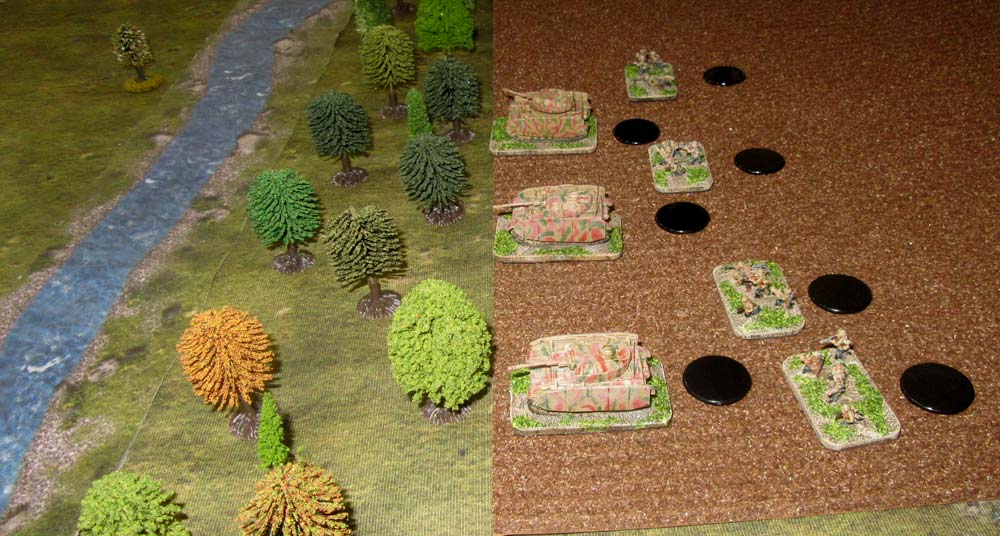 Obviously, these were colour coded – red for the Soviets and black for the Germans. Great Escape Games produce nice little MDF counters for this, but frankly the more garish plastic tiddlywink counters are far far cheaper! Anyway, we began with about a third of our force available. We both headed towards the river, but my Germans benefited from a line of trees beside it, which gave them a little bit of cover. As soon as we could, we began shooting.
Obviously, these were colour coded – red for the Soviets and black for the Germans. Great Escape Games produce nice little MDF counters for this, but frankly the more garish plastic tiddlywink counters are far far cheaper! Anyway, we began with about a third of our force available. We both headed towards the river, but my Germans benefited from a line of trees beside it, which gave them a little bit of cover. As soon as we could, we began shooting.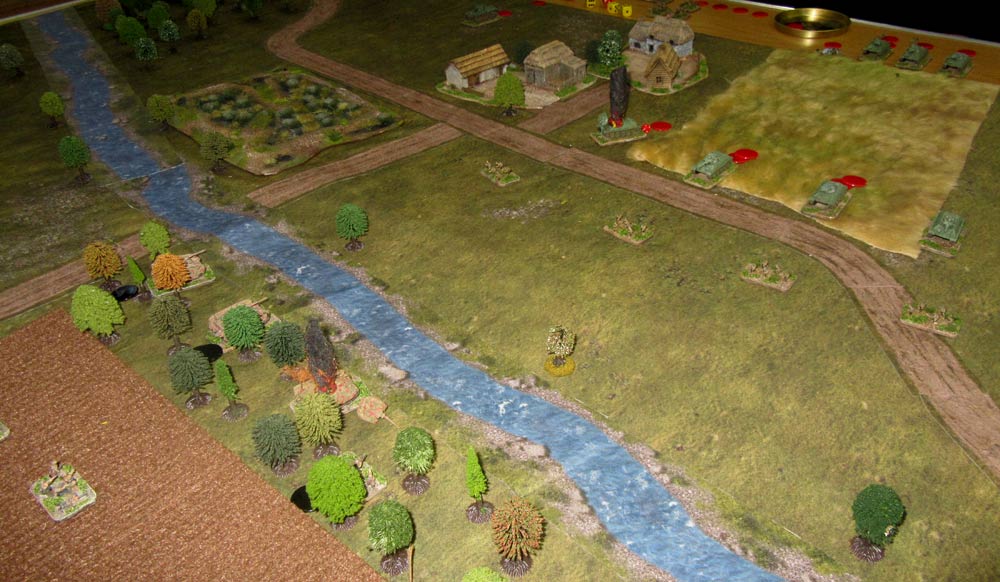 What followed was something of a duel, with two or three PzIVs taking on a slightly larger number of T-34s on the far side of the river. Once activated, firing is sown to a D10 roll to hit, then another one to penetrate. Even when both work out, there’s a third roll on a D6, to see if you knock out the enemy unit, or merely cause a scratch or two. The two sides were fairly evenly matched – or rather they were until we both brought on some heavier kit.
What followed was something of a duel, with two or three PzIVs taking on a slightly larger number of T-34s on the far side of the river. Once activated, firing is sown to a D10 roll to hit, then another one to penetrate. Even when both work out, there’s a third roll on a D6, to see if you knock out the enemy unit, or merely cause a scratch or two. The two sides were fairly evenly matched – or rather they were until we both brought on some heavier kit.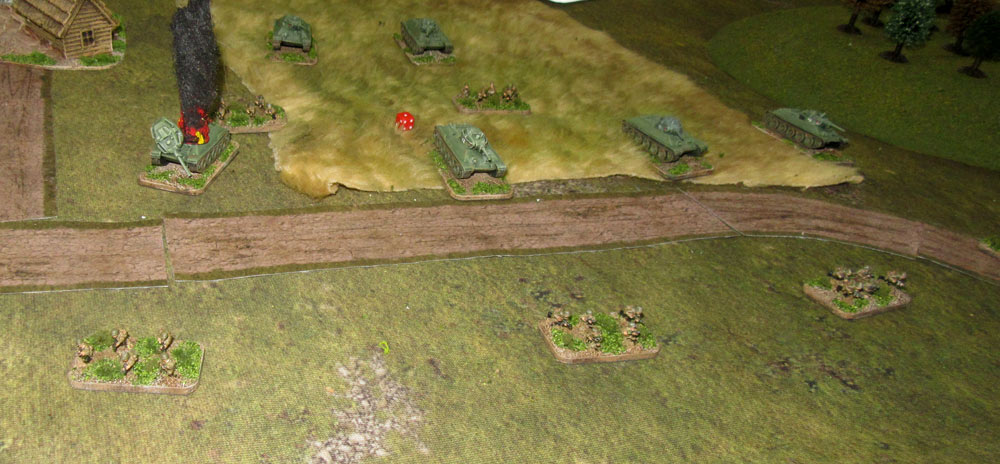 This too the form of a brace of Tiger Is for the Germans, and a couple of KV-1s for the Soviets. However, these would take a while to get involved in the scrap, and so it was down to the tanks already fighting it out across the river. We’d both thrown forward some infantry too, as they make the tankers nervous, and it’s slightly harder to hit a target, as the tankers are worrying about panzerfaust or AT rifle rounds coming their way.
This too the form of a brace of Tiger Is for the Germans, and a couple of KV-1s for the Soviets. However, these would take a while to get involved in the scrap, and so it was down to the tanks already fighting it out across the river. We’d both thrown forward some infantry too, as they make the tankers nervous, and it’s slightly harder to hit a target, as the tankers are worrying about panzerfaust or AT rifle rounds coming their way.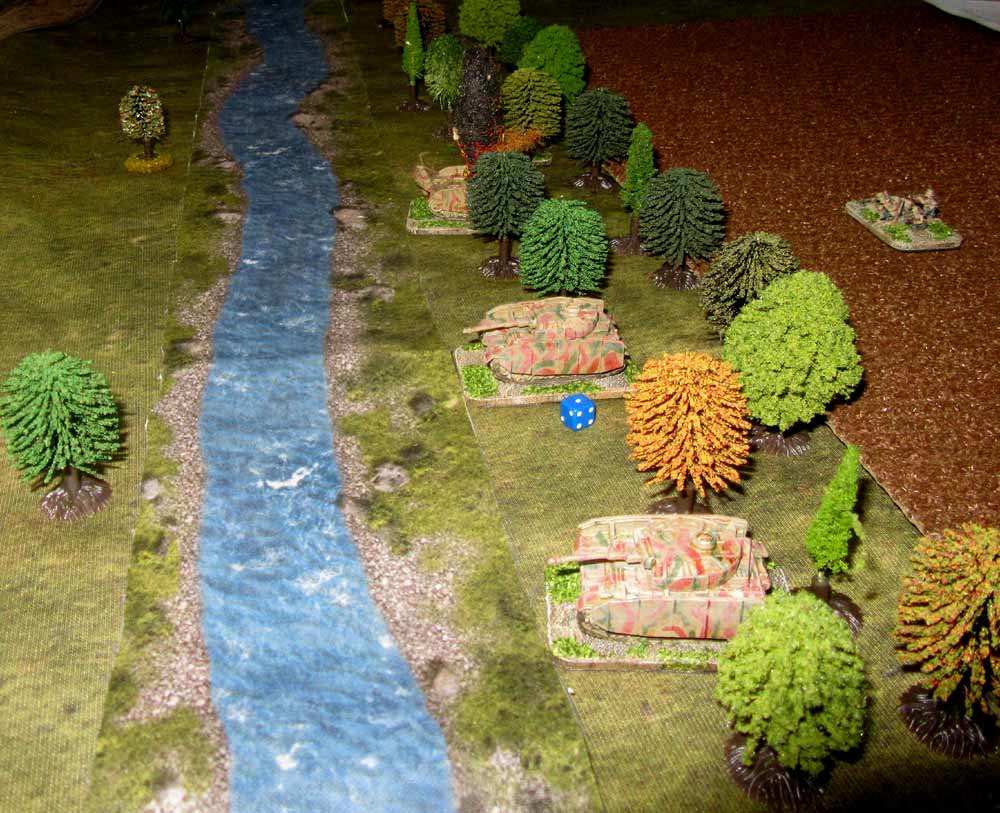 The tank duel saw both sides take losses, but this wasn’t too heavy yet – the bigger tanks still had to swing into action. The Germans lost a Marder III, and the Soviets a T-34 – so far. Nobody had crossed the river either, so my plan was to swing my Tigers and my second platoon of PzIIIs and IVs over the rover, so they could hit the Soviet tanks in the flank. Of course, I hadn’t thought this through, and didn’t realise it wouldn’t be quite that simple.
The tank duel saw both sides take losses, but this wasn’t too heavy yet – the bigger tanks still had to swing into action. The Germans lost a Marder III, and the Soviets a T-34 – so far. Nobody had crossed the river either, so my plan was to swing my Tigers and my second platoon of PzIIIs and IVs over the rover, so they could hit the Soviet tanks in the flank. Of course, I hadn’t thought this through, and didn’t realise it wouldn’t be quite that simple. 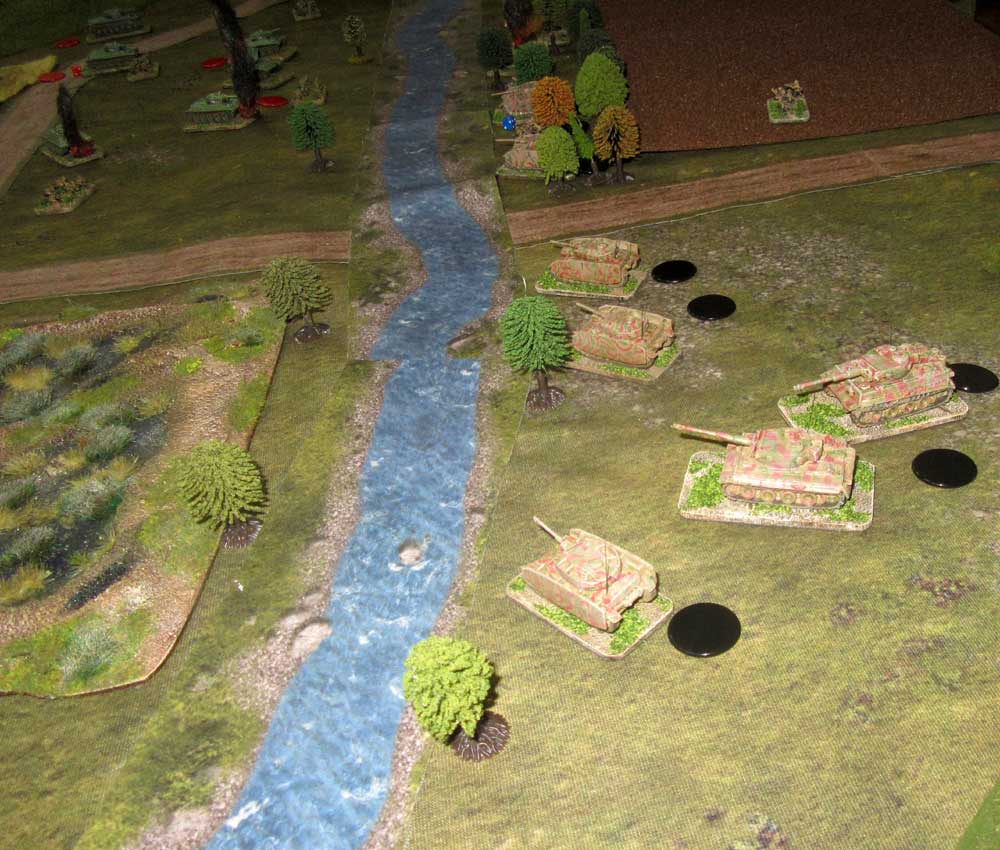 My Tigers finally joined in the fight, with one shooting at the enemy, while the other one forded the river – and promptly bogged down. The KV-1s entered the fray too, on the Soviet right, and one of them damaging one of my PZ IVs, but was promptly taken out by its companion. More troublesome was the second KV-1 in the village, which I couldn’t quite get a good line of sight to. It ruled the roost then, in the centre, damaging another Pz IV in the treeline.
My Tigers finally joined in the fight, with one shooting at the enemy, while the other one forded the river – and promptly bogged down. The KV-1s entered the fray too, on the Soviet right, and one of them damaging one of my PZ IVs, but was promptly taken out by its companion. More troublesome was the second KV-1 in the village, which I couldn’t quite get a good line of sight to. It ruled the roost then, in the centre, damaging another Pz IV in the treeline. 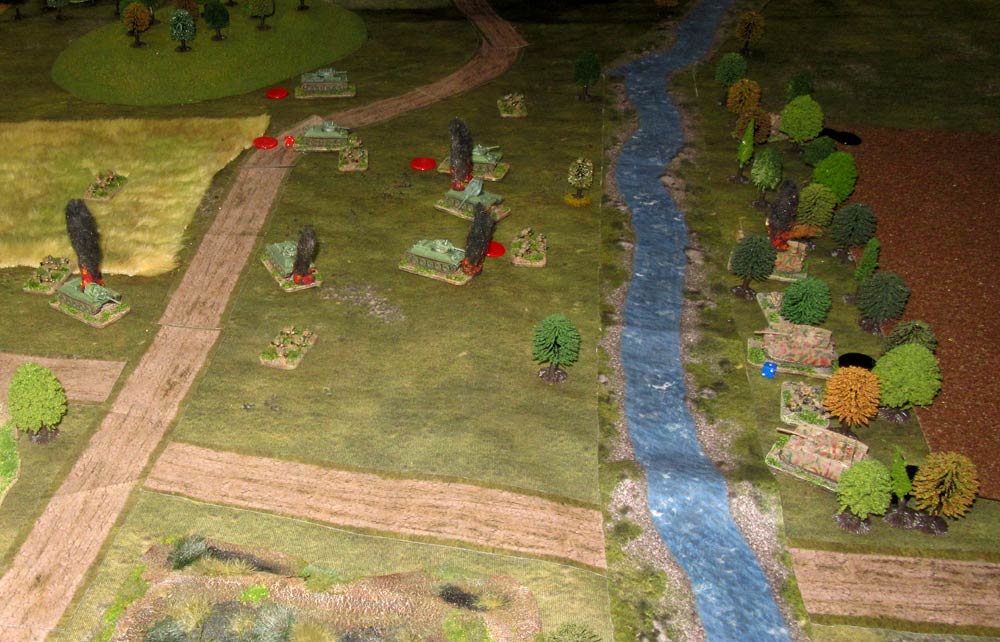 The tide turned when my bogged-dwon Tiger got moving again. It crossed onto dry ground, keeping clear of a nearby march, and began shooting into the flank of the Soviet T-34s. The first wave of Soviet tanks had now been destroyed, while the ones behind had trouble shooting – or being shot at – because of all the burning wrecks. This though, also meant that I could send more tanks across the river on my right – this time sticking to the ford.
The tide turned when my bogged-dwon Tiger got moving again. It crossed onto dry ground, keeping clear of a nearby march, and began shooting into the flank of the Soviet T-34s. The first wave of Soviet tanks had now been destroyed, while the ones behind had trouble shooting – or being shot at – because of all the burning wrecks. This though, also meant that I could send more tanks across the river on my right – this time sticking to the ford. 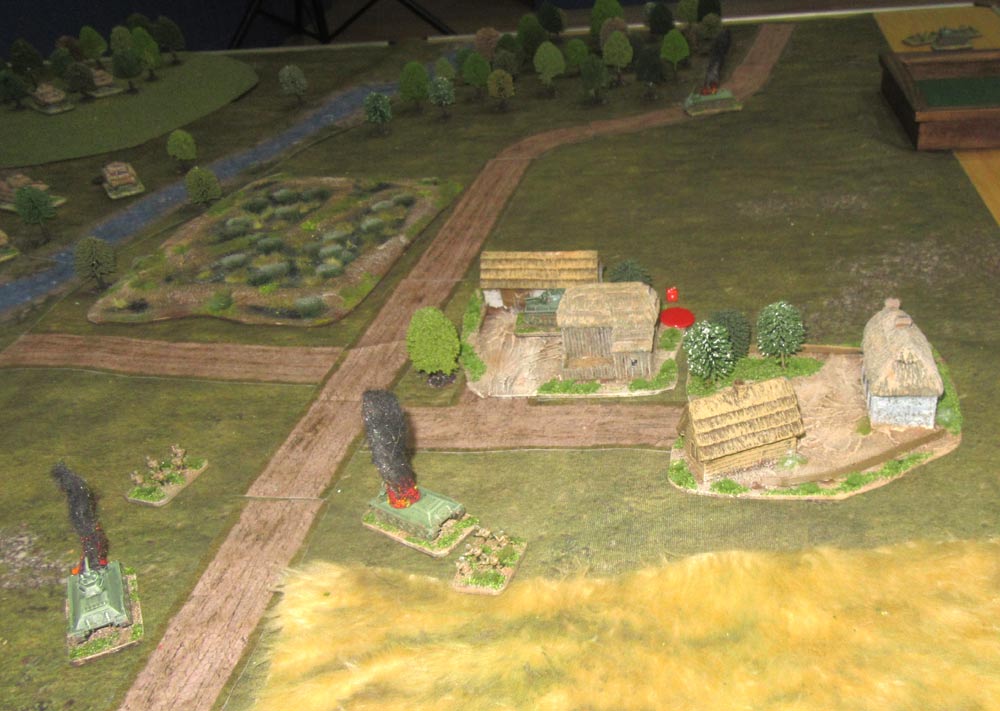 Once Das Reich got across the river it was pretty much game over for the Soviets. they were sort of hemmed in, and any attempt to advance would be fairly suicidal. So, Sean decided to concede, and trundle off the table to safety. All in all it was a clear German win, with two AFVs lost compared to six Soviet ones. Next time though, we’ll try it with a lot more Soviet tanks, including little T-70s, to see if they can overwhelm the enemy with sheer numbers.
Once Das Reich got across the river it was pretty much game over for the Soviets. they were sort of hemmed in, and any attempt to advance would be fairly suicidal. So, Sean decided to concede, and trundle off the table to safety. All in all it was a clear German win, with two AFVs lost compared to six Soviet ones. Next time though, we’ll try it with a lot more Soviet tanks, including little T-70s, to see if they can overwhelm the enemy with sheer numbers.  As for the rules, they work really well. Its only our third WW2 game with them – and Sean’s first, but he’d played the modern version, so he knew the basics. Aly, who was watching picked it up quickly too, as the basic game mechanics are simple. The key though, comes in how you husband your activation counters, as you can use them to intervene in your enemy’s turn – something that keeps the game really tense and exciting.It’s a great wee system.
As for the rules, they work really well. Its only our third WW2 game with them – and Sean’s first, but he’d played the modern version, so he knew the basics. Aly, who was watching picked it up quickly too, as the basic game mechanics are simple. The key though, comes in how you husband your activation counters, as you can use them to intervene in your enemy’s turn – something that keeps the game really tense and exciting.It’s a great wee system. 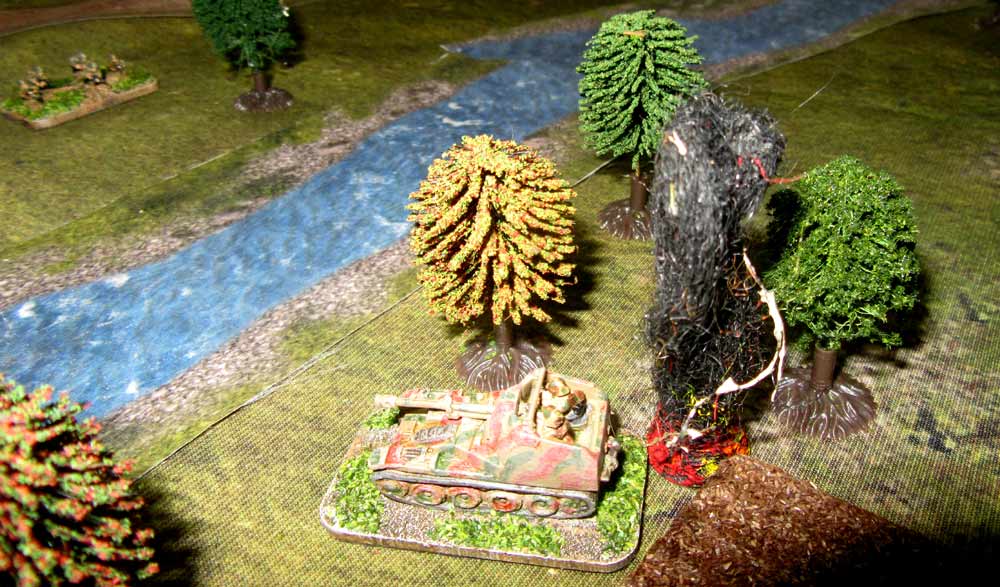


Interesting, always looking for new WW2 rules but had not heard of these. Do they work well for games with say….20+ tanks plus lots of infantry. I take it you get artillery too?
You guys sound pretty happy with them.
I think arty is,fairly abstracted, but it would be easy enough to layer in house rules for them. They’re designed to take lots of tanks, and infantry too. It’s the activation system that makes this, and their Cold War version, which we use for the Yom Kippur War, 1973.